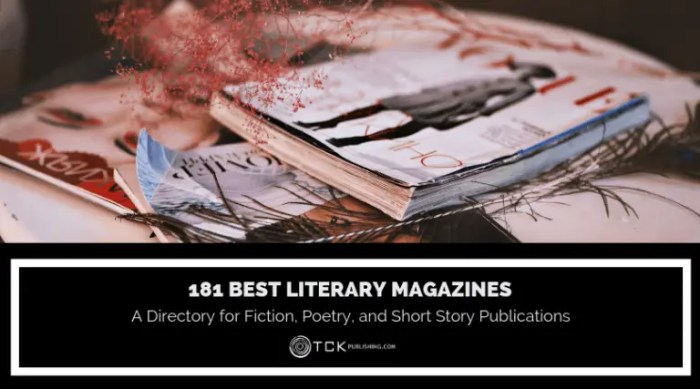
Embark on a journey to discover the best literary magazines for short fiction, utilizing online resources, social media platforms, and more to enhance your submissions and expand your writing horizons.
Learn how to research, submit, strategize, network, and draw inspiration from various disciplines to elevate your short fiction game in the literary world.
Researching Literary Magazines
When it comes to finding literary magazines for short fiction submissions, utilizing online resources can be incredibly helpful in discovering potential publications that align with your work.
Using Online Resources
One of the most effective ways to find literary magazines that accept short fiction submissions is by exploring online databases and directories specifically tailored to writers. Websites like Duotrope, Submittable, and NewPages offer comprehensive lists of literary magazines, along with detailed information about their submission guidelines and preferences.
Utilizing Social Media
Social media platforms can also be valuable tools in your search for literary magazines that specialize in short fiction. Following literary magazines on platforms like Twitter, Instagram, and Facebook can provide insight into their latest issues, submission calls, and even writer spotlights.
Reading Previous Issues
Before submitting your short fiction to a literary magazine, it’s essential to read previous issues to get a sense of their editorial style, themes, and the type of work they typically publish. This can help you tailor your submissions to fit the magazine’s preferences and increase your chances of acceptance.
Submission Guidelines

When submitting short fiction pieces to literary magazines, it is crucial to adhere to the submission guidelines set by each publication. These guidelines typically include instructions on word count limits, formatting requirements, and submission deadlines to ensure a smooth and efficient review process for editors.
Word Count Limits
Different literary magazines may have varying word count limits for short fiction submissions. Here are examples of common word count limits in various literary magazines:
- Magazine A: Accepts short fiction pieces up to 3,000 words.
- Magazine B: Prefers submissions between 1,000 to 5,000 words.
- Magazine C: Sets a strict limit of 2,500 words for all short fiction submissions.
Formatting Requirements and Submission Deadlines
Following formatting requirements, such as font size, spacing, and file format, is essential when submitting short fiction pieces to literary magazines. Additionally, meeting submission deadlines is crucial to ensure that your work is considered for publication in a timely manner. Failure to comply with these guidelines may result in your submission being overlooked or rejected.It is important to carefully review and follow the submission guidelines provided by each literary magazine to increase your chances of acceptance and publication.
By submitting your short fiction pieces in accordance with the specified word count limits, formatting requirements, and submission deadlines, you demonstrate professionalism and respect for the editorial process.
Building a Submission Strategy
Submitting your short fiction to literary magazines requires a well-thought-out strategy to increase your chances of acceptance. Here are some key steps to consider:
Creating a Tailored List of Literary Magazines
When building your submission list, it is crucial to target literary magazines that align with the genre and style of your short fiction. Consider factors such as the themes, tone, and writing style of your work to find magazines that are the best fit. This targeted approach increases the likelihood of your work resonating with the editors and readers of the magazine.
Benefits of Simultaneous Submissions
Submitting simultaneously to multiple literary magazines can significantly speed up the submission process and increase your chances of acceptance. By sending out your work to several magazines at once, you can receive responses more quickly and have a higher likelihood of getting published. However, it is important to keep track of where you have submitted your work to avoid accidental multiple acceptances.
Researching Editors and Editorial Preferences
Understanding the editors and editorial preferences of different literary magazines is key to crafting a successful submission. Take the time to research the editors of the magazines you are submitting to, as well as their past publications and any specific preferences they may have. Tailoring your submission based on this research can help you stand out and make a stronger impression on the editors.
Networking in the Literary Community
Attending literary events, workshops, and conferences can be a valuable way to connect with editors of literary magazines. These gatherings provide opportunities to interact with industry professionals, learn about the latest trends, and make meaningful connections.
Tips for Networking
- Introduce yourself confidently and engage in conversations with editors.
- Attend panel discussions or Q&A sessions to gain insights into the preferences of literary magazine editors.
- Exchange contact information and follow up with a polite email expressing your interest in submitting to their publication.
Joining Writing Groups or Online Forums
- Writing groups and online forums can offer a supportive community where you can receive recommendations for reputable literary magazines.
- Participate in critique sessions to improve your writing and gain valuable feedback from fellow writers.
Networking with Established Authors
- Engage with established authors at book signings, literary festivals, or online platforms to seek advice on the submission process.
- Establishing connections with authors who have been published in reputable literary magazines can provide valuable insights and guidance.
Exploring Cross-Disciplinary Inspiration
When it comes to creating short fiction for literary magazines, writers often draw inspiration from various disciplines beyond literature. Exploring cross-disciplinary influences can lead to unique and innovative storytelling techniques that captivate readers and elevate the narrative experience.
Painting Influence on Narrative Elements
Painting has the power to evoke emotions and imagery through visual art, which can greatly impact the narrative elements of short fiction. Just like a painter carefully chooses colors and brushstrokes to convey a specific mood or theme, writers can use descriptive language and vivid imagery to create a similar effect in their stories. By studying paintings and understanding how artists tell stories through visuals, writers can enhance their own storytelling skills and create more immersive narratives.
Role of Performing Arts in Character Development and Plot Structures
The performing arts, such as theater and dance, play a crucial role in shaping character development and plot structures in short fiction pieces. Actors bring characters to life through their emotions, gestures, and interactions, inspiring writers to create more dynamic and multi-dimensional characters in their stories. Additionally, the dramatic arcs and conflicts in theatrical performances can serve as a blueprint for crafting engaging plot structures that keep readers hooked until the end.
Connection Between Philosophy and Themes in Short Fiction
Philosophy often explores complex ideas and fundamental questions about the human experience, which can deeply influence the themes explored in short fiction published in literary magazines. By delving into philosophical concepts such as morality, existentialism, or the nature of reality, writers can infuse their stories with deeper meaning and thought-provoking themes that resonate with readers on a profound level.
Photography’s Influence on Visual Storytelling Techniques
Photography offers a unique perspective on storytelling through visual imagery, which can inspire writers to incorporate visual storytelling techniques in their short fiction writing. Just like a photographer composes a shot to convey a specific narrative or emotion, writers can use detailed descriptions and sensory details to paint a vivid picture for readers. By studying photography and understanding how images can evoke storytelling, writers can enrich their narratives and create more compelling and visually engaging stories.
Understanding Visual Graphic Arts in Literary Magazines

Visual art plays a significant role in enhancing the presentation of short fiction in literary magazines. The collaboration between visual artists and writers can create compelling narratives that engage readers on a deeper level. Additionally, graphic design elements contribute to the overall aesthetic appeal of literary magazines featuring short fiction.
The Use of Visual Art in Enhancing Short Fiction
Visual art, such as illustrations or photography, can add a new dimension to the storytelling experience in literary magazines. By visually representing characters, settings, or emotions, visual art can complement the written narrative and provide readers with a more immersive reading experience.
Collaboration Between Visual Artists and Writers
When visual artists and writers collaborate, they can merge their creative visions to produce unique and captivating stories. Visual art can inspire writers to explore new themes or directions in their writing, while writers can provide context and depth to the visual elements. This partnership often results in a harmonious blend of words and images that resonate with the audience.
Contribution of Graphic Design Elements
Graphic design elements, such as layout, typography, and color schemes, play a crucial role in shaping the overall look and feel of a literary magazine. These elements help create a cohesive visual identity for the publication and enhance the readability of the content. By incorporating graphic design principles, literary magazines can attract readers and create a memorable reading experience.
In conclusion, mastering the art of finding literary magazines for short fiction opens doors to a vibrant community of writers and readers, shaping your narrative voice and artistic vision in profound ways. Dive into this enriching experience and watch your stories soar across the pages of prestigious literary publications.
Question & Answer Hub
How can I know if a literary magazine is a good fit for my short fiction?
Research the magazine’s previous issues, editorial style, and submission guidelines to ensure alignment with your writing.
Is it advisable to submit to multiple literary magazines simultaneously?
Yes, but make sure to keep detailed records of each submission to avoid conflicts or confusion.
How important is it to network with editors of literary magazines?
Networking can provide valuable insights, opportunities, and connections that may enhance your chances of acceptance.





